Abstract
The main purpose of this study is to survey the scientific literature and try through bibliometric means to position the concept of organizational culture (OC) in a changing environment, governed today by sustainability goals. In such conditions, always appear new factors of influence and OC itself can exert a powerful impact on specific features of the organizational environment. The methodological approach comprises and follows four phases developed by the authors in accordance with recent and similar research. Main findings suggest that the interest of authors along time has fallen on the impact of OC at first rather than of OC determinants. Also there are many differences in terms of authors, sources, international cooperation, keywords and impact of scientific research between documents regarding the determinants of OC and documents related to the impact exerted by OC.
1. Introduction
Over time, the concept of organizational culture (OC) has aroused the interest of researchers, being the object and subject of study of several scientific papers, especially in the field of management and business [1,2,3]. In the literature, organizational culture has been analyzed from several points of view, with researchers trying to explore even the role that organizational culture can play on sustainable practices encouraged by companies [4] or how the organizational culture is influenced by several factors [5,6,7]. The present research focuses on this concept, as it appears from the bibliographic study of the literature; it is a concept balanced between the influencing or determining factors of it, and the influences that it exerts in its turn.
Well-conducted bibliometric studies can build a solid foundation for advancing a field in new, meaningful ways for general knowledge—enables and empowers researchers to (1) obtain a unique overview, (2) identify gaps in what is known, (3) obtain new ideas that are worth investigating, and (4) properly position the intended contributions in connection with a specific field. All these listed elements are, moreover, arguments in favor of the bibliometric analysis use in the present research. The main objective is to discover the existing legitimacies between the elements that compose and determine OC at the level of an organization as a whole, and also between the concept itself and the elements that are being influenced by it. Some of those elements are directly connected to the concept of sustainability. So, in this paper we provide a closer examination of the relationship between organizational culture and sustainability, which in fact is a theme tangentially treated in the literature. In some recent researches, this relationship can be described by referring to aspects indirectly connecting the two concepts, such as: innovation or development according to some authors [8], or to corporate social responsibility [9] or even to competitive advantage [10], knowledge management [11] and to leadership [12]. In this way, one can in the end try to explain if it is possible for organizations to become more sustainable through culture and more specifically, through approaching elements characteristic to organizational or corporate culture.
The present research follows the logical steps of a scientific research, starting with the study of the literature regarding the concepts of bibliometric analysis and organizational culture, continuing with the presentation of the methodology established by the authors and then with the actual analysis.
2. Literature Review
Bibliometric analysis is a rigorous, increasingly popular method used to analyze and explore large volumes of scientific data. Bibliometric analysis is part of the text mining technique, which is used by many authors to quickly analyze large amount of information, in order to discover patterns and trends related to a specific topic [13,14]. By using the bibliometric analysis we have the possibility to dissect the evolutionary components of a certain field of study, bringing to the surface, at the same time, the emerging areas of the respective field of study [15]. Historically, according to Kataria et al. [16], Pritchard first introduced bibliometric analysis in 1969 as a method of applying statistical and mathematical tools to books or other means of communication. Currently, the technique is useful to provide an informative overview of the field of targeted research, and also to graphically summarize the trends in the field [17,18,19].
Bibliometric analysis has become increasingly popular in recent years, being applied to various fields and topics [20,21,22,23,24,25], but its application in the research of aspects related to the private environment or the evolution of business is still in its infancy, being in many cases underdeveloped. However, the growing popularity of this scientific method is due to many aspects such as: advanced scientific nature, availability and accessibility of bibliometric-specific software such as VOSviewer, Gephi, Leximancer, and scientific databases such as Web of Science and Scopus. At the same time, another equally important criterion that has contributed to the growing popularity of the method is the multidisciplinary nature of the results, which has allowed the transfer of working methodology from information science to business research [26,27]. Going further, the popularity of bibliometric analysis is not given by the fact that it is another method of researching the subdomains of a business or field of study, but rather by the utility of the method itself, which derives from the processing of large volumes of scientific data, with a high impact on the research itself regardless of the field. Given the usefulness of using this scientific method, over time, various specialized articles related to the organizational culture analyzed by bibliometric methods, have appeared. Some examples can be found in Table 1.

Table 1.
Selection of bibliometric studies on topics related to organizational culture.
Thus, considering all of the above, the bibliometric analysis finds and justifies its role in the present research. The main objective of such a study is to highlight the determinants of organizational culture (as they have been studied over time in the literature), and also the influences it has on other intrinsic and extrinsic elements to the organizational environment. One of these elements is sustainability, a common concept nowadays given its widespread importance. According to Oriade et al. [38], there is a strong relationship between organizational culture and management practice of sustainability, with a strong advantage in employees’ sustainability awareness. Before developing the actual bibliometric analysis, in the next subchapter we made a quick assessment of the literature on the concept of organizational culture, its determinants, and also the influences it can further exert.
As shown in Figure 1, organizational culture is influenced by many factors, the most common influence being the impact of internal and external factors. Thus, below we will present a classification of them according to Freedom Learning Group [39] and Szczepańska & Kosiorek [40]:
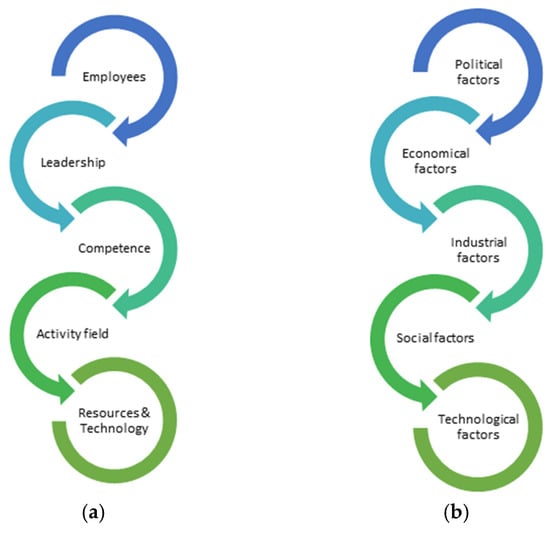
Figure 1.
Internal (a) and external (b) factors influencing OC.
- (a)
- Internal factors
Employees—each person identifies with a unique set of personality traits, respectively with specific experiences. Organizations cannot fully control the actions of individuals, but they can use various guidelines to direct employee behavior. The mission of the organization, the code of ethics, the internal regulations, the policies and the procedures are tools that the entities can use in order to influence the actions of the individuals;
Leadership—organizational culture is closely linked to the leadership of the organization, a weak leader can have a significant negative impact on the culture of the entity. Leaders often lead by example and set standards for expected behaviors, so non-compliance often leads to situations where employees demonstrate the same types of actions;
Competence and support—employee training and development issues are an important part of organizations’ success. An important criteria in the support of the employees by the organization is the provision of support and training courses in order to fulfill the service tasks. With the support of the entity, the employees show peace and self-control, being happy at work, transmitting positive feelings throughout the organization;
Activity field—each industry has specific elements that shape the organizational culture. While ethical specifications should be universal, standards and expectations differ depending on the field of activity. It is important for the entity as a whole to be aware of those elements that are important to it that give value to the organizational culture;
Resources and technology—the success of an organization is ensured by providing the necessary resources to employees. The inability to provide individuals with the resources needed to perform their duties largely leads to the accumulation of frustrations, settled from one period to another. The existence of resources entails increasing the efficiency of employees, which leads to the improvement of the organizational culture.
In order to manage all these factors, organizations use a number of tools to develop and maintain the organizational culture: the vision of the organization; the mission of the organization; Code of ethics; Policies and Procedures.
Regarding external factors, we will present a classification of them according to Freedom Learning Group [41] and Kapur [42].
- (b)
- External factors
Political factors—the political environment creates laws and regulations that influence the way organizations operate. They are required to comply with and harmonize their domestic and/or international laws. Political issues can influence the activity of small or large-scale entities, with actions influencing the organization’s objectives and the way it operates;
Economic factors—these factors play an important role in everyday life. How much money we produce, how much we spend, desires and needs, competitive prices, all these are factors that influence the financial decisions we make every day. The phases of the economic cycle (recession vs. expansion) directly impact the sales of an organization. When individuals are more attentive to the way they consume their resources, companies are directly impacted. The organizational culture of the entities is influenced by their ability to adapt to changes in the economy, and by the ability to adjust their strategies according to specific actions;
Industrial factors—the actions of competitors influence the decisions taken by organizations. To ensure the longevity of the entity, it must be able to adjust its organizational culture to the actions of the competition. Also, other factors of an industrial nature that influence the organizational culture are the industry standards that evolve over time, and also the specific safety regulations;
Social factors—public opinion plays a key role in the process of re-evaluating the way organizations operate. A negative public perception can have a substantial impact on the organization as a whole. The public is attentive to issues related to social responsibility (helping the community, promoting diversity, sustainability, etc.) elements that must be incorporated into the organization’s culture to ensure success;
Technological factors—technology is an important factor in influencing the behavior of organizations, it evolves substantially from one period to another. Technology is constantly updating and changing and influencing the organizational culture precisely by ensuring productivity growth and facilitating the successful accomplishment of individuals’ tasks.
Organizations cannot eliminate the influence of external factors on activities, and must have the ability to manage them in the best possible way. This can be done by accessing credible sources of information. Another element that allows the management of external factors is the education that can be provided through training and development programs. The third crucial element for the management of external factors is the one related to the relations that the organization has with the stakeholders (customers, suppliers, authorities, etc.). The activities of the organizations cannot take place without the involvement of the partners, so it is crucial that they are in good relations with the entity.
Organizational culture is influenced by many factors shown in Figure 1. However, in the literature, two key elements have been identified in shaping and sharing organizational culture: Transformational Leadership and Organizational Communication Media.
Transformational—Shao et al. [43] and Vaiseh et al. [44] mentioned in their writings about this determining element of organizational culture. According to Bateman and Snell [45], transformational leadership (TL) is associated with activities that motivate individuals to go beyond their own interests for the good of the group. They directly influence individuals through charisma, caring for others, and through existing incentives [46]. According to Bass and Avolio [47], TL related to organizational culture can be assessed through four indicators: idealized influence, inspirational motivation, intellectual stimulation, and individualized consideration.
Organizational Communication Media—how information is communicated within entities plays a key role in creating and maintaining organizational culture [46]. At the level of an organization, we can find different means of communication: magazines, software applications, common online platforms, etc. All these are favoring the transmission of information formally or informally so that the message appropriately reaches all participants [48].
The factors that influence the organizational culture (Figure 1) together with the two determinants play an essential role in shaping the organizational culture and its perpetuation over time. From one organization to another, all these elements differ, being unique, which leads to a different feeling of their effects at the level of organizations depending on the field of activity. All these interconnected elements influence the perceptions, attitudes, behavior of the members of the organizations, so they create the organizational culture.
Regarding the impact of OC on entities, Lim [49] points out that there is a link between the performance of the organization and its specific culture. According to experts, OC is largely based on social issues, which can lead to influence on decisions and employee behavior, in the spirit of increasing performance. In other words, OC can be assimilated with a social glue, this “tying” the employees and making them feel part of the entity, a useful aspect in order to attract newly qualified staff or to keep employees performing. Moreover, organizational culture contributes to raising awareness of organizational processes, helps employees understand organizational goals, which increases efficiency and effectiveness, and thus performance as a whole [50]. According to Saffold [51], a strong OC improves employees’ self-confidence, reduces stress at work and improves their ethical behavior.
In addition to the impact on performance, the relationship between innovation and OC has been studied over time in the literature. According to Szczepanska-Woszczyna [52], in order to ensure the development of the company, it is necessary for the management to have an entrepreneurial attitude and to be continuously interested in the innovation activity, whether we are talking about revolutionary, new inventions or minor modernization activities which, however, bring measurable effects to the organization.
According to Matinaro & Liu [53], increasing the degree of sustainability at national and global level can be achieved through activities characterized by a high degree of innovation and creative thinking. As a result, shaping an innovation-oriented organizational culture is the path to sustainability. The authors of this paper recognize a need for a more detailed definition of the concept of sustainability. According to WCED [54], by sustainability we understand “the ability to meet current needs without compromising the ability of future generations to meet their own needs”. Through sustainability, companies no longer focus only on the economic value, but also consider the social and environmental value of the actions they carry out [55]. In this way, Grayson et al. [56] stated that companies with a strong sustainability performance display a specific OC.
In order to reduce the environmental impact, sustainable companies executes various environmental actions using sustainability management tools [55,57,58,59]. In this way, companies around the world can develop a green organizational identity due to environmental sustainability orientation [60]. Given the green OC identity, companies can achieve a green competitive advantage, including eco-innovation [55,61,62,63,64].
According to researchers, one of the main reasons of failure regarding the implementation of organizational change programs is organizational culture [65]. As a result, organizations that want to be innovative need to transform their OC so that it is pro-innovative. Loewe and Dominiquini [66] stated that values and OC are key areas for the effective implementation of innovation along with leadership behavior, management processes, people and their skills. OC can promote cooperation, exchange of knowledge, experiences and ideas between partners, and an open organizational culture promotes the participation of all team members in the creative process, a favorable aspect for the activity and initiative of employees. Other authors express this as part of knowledge management influencing firm innovation [67]. Moreover, the key to the development of innovation in an organization is the support and encouragement of each employee to seek and develop unconventional, non-standard ways to achieve the set goals and fulfill the established tasks [52].
3. Materials and Methods
Regarding the methodology underlying the development of this research, it is clearly presented, step by step in Figure 2. The working methodology is a vision of the authors, built on a structure found in Janik, Ryszko and Szafraniec [68] and based on the so-called concept of “science mapping” developed by Aria and Cuccurullo [69].
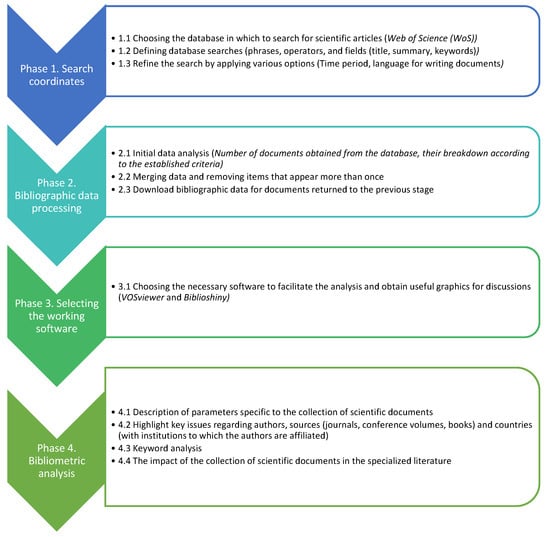
Figure 2.
Methodological phases.
Regarding the first step mentioned in the methodology, it is necessary to provide supporting arguments for using only one database. The chosen database was Web of Science due to the fact that it comprises top quality journals publishing papers written by top reputed scholars in a particular field. It is also a database which provides the bibliographic information in formats supported by many software programs. However, selecting only one database is a precondition for further using a software for the bibliometric analysis. As far as we are concerned, there is no bibliometric software capable of using in the same time bibliographic information extracted from more than one database. The difficulty of using and merging two collections of documents from different databases, appears as a consequence of differences in terms of content and string format.
After completing the first two steps mentioned in Figure 2, there were 63 scientific papers that make up the set (a) of the documents on the determinants of OC and 334 documents that make up the set (b) of the documents on the impact of OC. Practically, the influences of OC are the object of research of many more scientific researches in various fields and highlight the fact that, once developed, OC has the power to determine in turn changes on other parameters in the environment of organizations.
In Table 2 you can see how to search the database (search performed only in the title—TI; search for plural forms or words derived from the base word, using the graphic sign *; search of both forms: organizational and organisational by using the graphic sign ?), respectively the number of obtained articles, and then left after refining the search with the two options: documents written in English and excluding 2021 from the analysis, on the grounds that it is not a full year in terms of scientific publications on the topic of interest.

Table 2.
Configure WoS search and returned documents, respectively left over after refining the search.
4. Results
4.1. Presentation of the Collection of Scientific Documents
The collection of scientific documents (articles, papers from conferences, books, etc.) was organized taking into account the two elements against which the concept of OC is positioned in the present research: the factors that influence it, and the impact it has on other parameters in the organizational environment (see Table 3). Thus, the following table contains the elements that describe the collection of documents on the two levels indicated: (a) documents related to the determinants of OC, and (b) documents related to the impact of OC. It can be seen that set (b) of documents extends over a much longer period of time, a sign that the topic of OC impact has a greater significance, it was studied before the one on the determinants of OC. In both sets of documents, articles published in scientific journals predominate, followed by papers presented at conferences and published in their volumes, however documents from the main flow of the literature (fact also shown in Figure 3). In terms of collaboration between authors, it is similar for one theme and the other, with such a value (approximately 2.9) suggesting a medium level of collaboration between authors.

Table 3.
Descriptive elements of the collection of scientific documents.
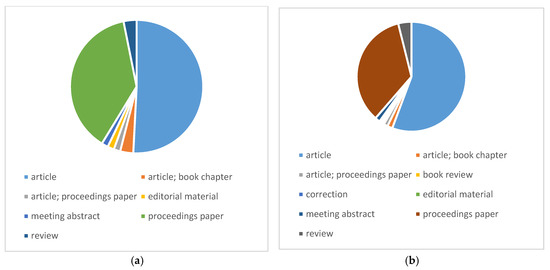
Figure 3.
Type of documents. (a) documents related to the determinants of OC, and (b) documents related to the impact of OC.Source: authors with data from the WoS database.
According to Figure 4, both topics (a) and (b) have ups and downs over the studied periods, which means that the increased interest of researchers is manifested in certain years, or breaks of several years (most the long break is 10 years for topic (b) of the impact of OC), prior to some research, in which the interest was clearly reduced. However, according to the graphs, since 2013, both topics have gained momentum in research, the scientific documents thus published, maintaining an upward trend until 2019.
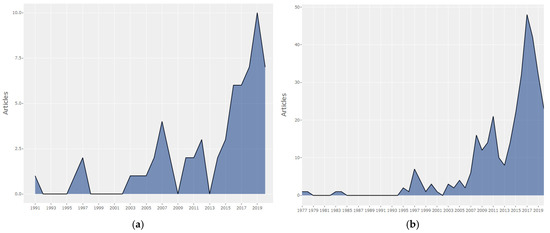
Figure 4.
Annual scientific production (a) documents related to the determinants of OC (b) documents related to the impact of OC. Source: authors with Biblioshiny.
An aspect of high importance is shown in Figure 5. This indicates the largest contributor, as a provider of scientific papers on OC and its influencing factors, and its impact, namely the United States of America. Romania is also in both rankings, even among the top five for ranking (b). The two graphs also show two measurements: (1) MCP—multiple country publications (refers to those documents that have at least one co-author from another country); (2) SCP—single country publications (refers to documents whose co-authors are from the same country). One can easily see the high proportion of SCP compared to the MCP in both situations, which in fact indicates a low or even very low degree of international cooperation for countries where only SCP values have been reported.
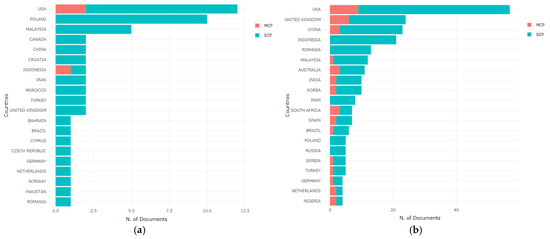
Figure 5.
The origin country of the corresponding author (a) documents related to the determinants of OC (b) documents related to the impact of OC. Source: authors with Biblioshiny.
Regarding the classification of documents by areas (WoS categories), it can be seen from Figure 6 that most of them are included in the categories “Business” and “Management”, which we expect, if we consider the specifics of the topic covered in this analysis.
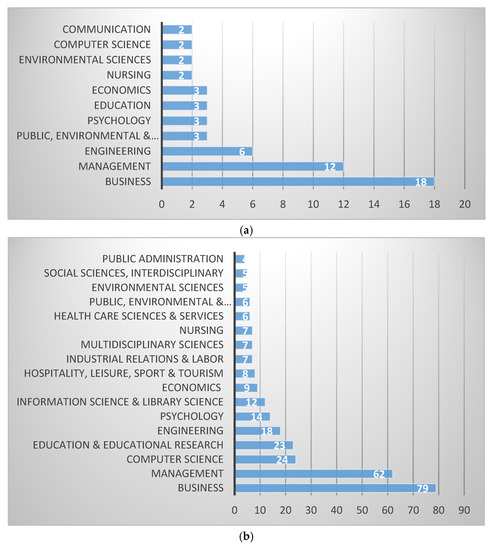
Figure 6.
Main WoS categories of scientific documents (a) documents related to the determinants of OC (b) documents related to the impact of OC. Source: authors with Biblioshiny.
4.2. Key Aspects of the Authors and Sources Contribution to the Scientific Papers Collection
4.2.1. Focus on the Authors
Figure 7 shows the top 15 authors with the most contributions (as a percentage) to the documents’ collection. Among them is the author Conțiu [70,71] with two scientific papers presented at international conferences, papers on the influence of OC on competitiveness in higher education institutions, and also on knowledge management. Regarding these authors, the following figure (Figure 8) shows how their contributions were distributed over time (by drawing a specific number of circles). The size of each circle represents the number of publications in a year, so larger the size of a circle, than more scientific publications in a year.
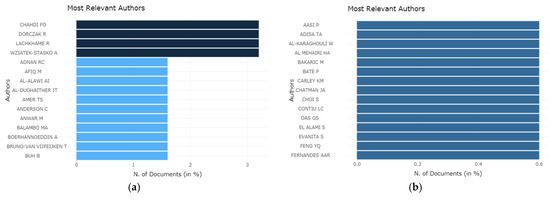
Figure 7.
Authors with the most contributions (a) documents related to the determinants of OC (b) documents related to the impact of OC. Source: authors with Biblioshiny.
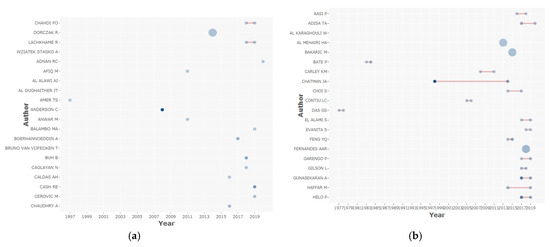
Figure 8.
Authors contributions in time (a) documents related to the determinants of OC (b) documents related to the impact of OC. Source: authors with Biblioshiny.
The color of each circle provides information on the number of citations received by those publications, so a more intense blue color suggests a high number of received citations. As expected, the number of research works focuses on the right side of both graphical representations, a sign that the scientific production on OC has developed a lot in the last decade. Notable, for example, for the (a) set of documents, the authors Anderson, Spataro and Flynn [72], whose work obtains about six citations per year and a total of about 83 citations. Also for this set of documents, one can see a first attempt of research in the field, in the first part of the period, of the author Amer [73], which in fact represents a review of a paper by Dunk and Roohani [74] studying the relationship between OC and information technology.
The research work of Chatman et al. [75] with an average of 17 citations per year and a total of approximately 400 citations, stands out for the set of documents corresponding to the classification (b), impact of OC. Also here, two pioneering researches in the field of OC impact, are those of the authors Singh, Mathew and Das [76], and Singh and Das [77], both on the influences of OC on the commitment to work, and on the remuneration of managerial work.
The dotted line in Figure 9 represents the theoretical distribution of scientific productivity in Lotka’s Law, and the blue area represents the distribution associated with the documents in our collection. Aria & Cuccurullo [69] explain Lotka’s law by referring to the fact that as the number of published articles increases, the number of authors who reach that number decreases. Thus, for situation (a), we have over 90% of the authors with unique contributions to the collection of documents to be analyzed. For situation (b) we have over 80% for authors who contributed with only one scientific paper. It can be seen that the two values are higher than the theoretical distribution of Lotka’s law, which includes them in the category of authors with “occasional” contributions. On the right side of each graph, one can see the percentage of authors who contributed with 2 documents, about 5% in both situations.

Figure 9.
Authors productivity (a) documents related to the determinants of OC (b) documents related to the impact of OC. Source: authors with Biblioshiny.
Another category of authors that we can refer to through bibliometric analysis is the one that presents the authors cited in the collection’s documents. Thus, Table 4 presents the first ten ranks occupied by the most cited authors, in the references from the analyzed scientific documents. It can be seen that, regardless of the set of documents, (a) or (b), the same first three authors occupy the leading positions, Schein, Hofstede and Cameron.

Table 4.
The most cited authors in the collections’ references.
4.2.2. Focus on the Sources
A source is, as mentioned before, a journal, a book, a conference proceedings etc. Our collection of scientific papers has a total of 352 sources (61 for set (a) and 291 for set (b)). Figure 10 and Figure 11 are intended to provide information about the main sources in the collection, according to Bradford’s law. Thus, the sources are grouped into three zones, each with a similar number of articles (one-third of the total) [78]. The first area was called the core area, comprising the so-called journals devoted to the sought subject. Thus, for the topic on OC determinants, according to Figure 10, there are 19 sources included in the core area. Table 5 shows that of these 19 sources, the first 9 are conference proceedings, while the other 10 are journals. According to Bradford’s law, in fact, these 19 sources published a third of the documents included in our collection.
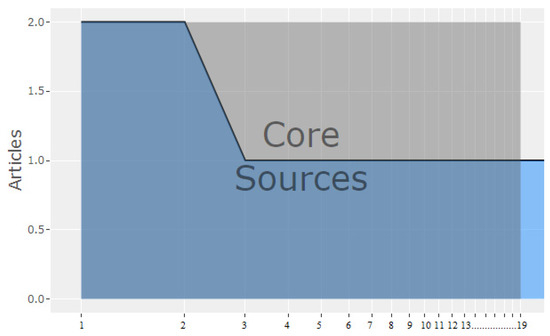
Figure 10.
Main sources for documents related to the determinants of OC. Source: authors with Biblioshiny.
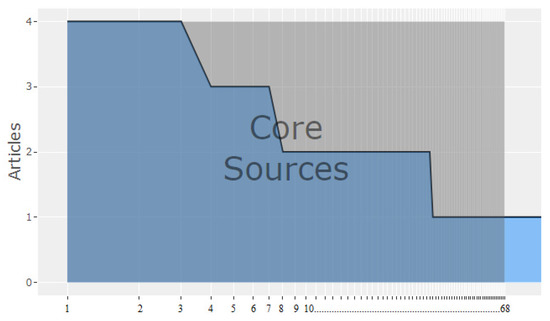
Figure 11.
Main sources for documents related to the impact of OC. Source: authors with Biblioshiny.

Table 5.
Ranking of the main sources for the documents related to the determinants of OC.
For the topic of OC impact, according to Figure 11, there are 68 sources included in the core area. Table 6 shows that among these, in top 20, the majority represents scientific journals and only one is a conference proceedings. According to Bradford’s law, for set (b), all 68 sources published a third of the documents included in the studied collection.

Table 6.
Ranking of the main sources for the documents related to the impact of OC.
4.3. Keywords Analysis
This type of analysis involves separating the two sets of documents, (a) and (b) and presenting graphical elements returned by the two software, VOSviewer and Biblioshiny, in order to find both links that OC forms with other concepts, the power of the link between them, to find keywords frequency (either those provided by the authors or the keywords PLUS, words that appear frequently in the titles find in references, not in the titles of the articles themselves), how certain topics of discussion are grouped in the conducted research and how they change over time, and least but not last, the authors’ interest shifting and focusing on new topics.
4.3.1. Keywords Analysis for the Documents Referring to Determinants of OC
For documents on OC determinants, keyword analysis begins with tree charts, both for the keywords provided by the authors (Figure 12) and for the PLUS keywords (Figure 13). The size of each spot in the tree is given by the frequency with which the keywords appear. It can be noticed that in the specialized literature the word combination “organizational culture” predominates and that only in a certain proportion “organisational culture” for OC also appears. The term “organizational” is replaced in some works with “corporate”, hence the word combination (with a low frequency of occurrence through keywords) “corporate culture”. Among the words in the first tree defining elements of OC can be found, such as “values” and “attitudes”, while the words “innovation” and “performance” appear in both structures (although with different frequencies, they refer to the implications of OC in the organizational environment).
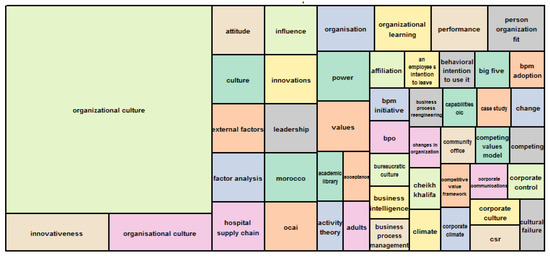
Figure 12.
Authors’ keywords tree. Source: authors with Biblioshiny.
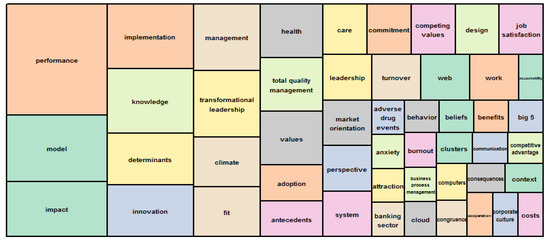
Figure 13.
Keywords PLUS tree. Source: authors with Biblioshiny.
The tree in Figure 12 clearly provides words related to the internal determinants of CO, as they were presented in the previous section (the literature review). Thus, the keywords that refer to internal factors are:
- Employees: ”an employee’s intention to leave”, ”behavioral intention to use it”, ”big five” (with reference to personality dimensions), ”person-organization fit”.
- Leadership: ”leadership”, ”power”, ”Bpm initiative”, ”business process reengineering”, ”bpm adoption”.
- Competence and support: ”organizational learning”, ”affiliation”, ”capabilities olc” (organizational learning capabilities), ”climate”, ”corporate climate”.
Among the keywords, one in particular refers to a method by which organizations can identify the predominant type of organizational culture, “OCAI”. For external factors, the following keywords stand out: “csr” (corporate social responsibility), “community office” belonging to the category of social factors, and also “business intelligence” belonging to the category of technological factors.
As for Figure 13, contains words similar to those exemplified for the authors’ keywords tree, to which the following may be added:
- For Employees: ”beliefs”, ”work”, ”job satisfaction”, ”behaviour”, ”benefits”;
- For Leadership: ”leadership”, ”transformational leadership”, ”total quality management”, ”business process management”;
- For external factors the following keywords stand out: “costs”, “competitive advantage”, “accountability” belonging to the category of economic factors.
Figure 14 represents a map (in the form of a network graph) of all the keywords (both those given by the authors and the Keywords PLUS), grouped in clusters of various colors, and also of the links among them (here, the links show how many times the respective words or phrases have been found together in the same scientific document; a link may be drawn thicker or thinner depending on the number of co-occurrences of the words or phrases). The nodes in this network have different sizes, depending on the keywords frequency of appearance in the collection’s documents. In general, the closer two keywords are (as a location on the map), the stronger the link between them.
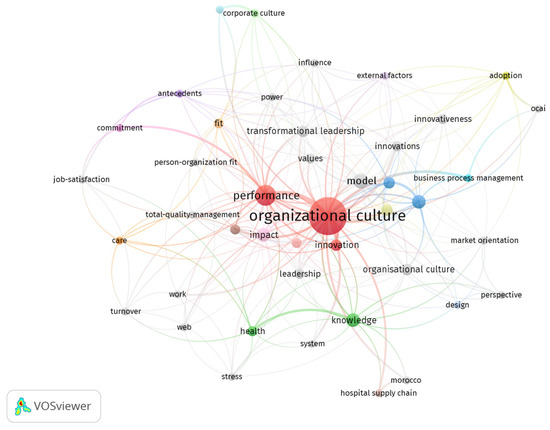
Figure 14.
The map of keywords’ links. Source: authors with VOSviewer.
The second map, which can be seen in Figure 15, covers the period 2005–2020, for which the selected keywords are characteristic (they have a high number of occurrences). The map focuses on “corporate culture” in 2005 and on “organizational culture” in 2015. Regarding keywords such as “innovation”, “ocai”, “stress” and “knowledge”, these are the main concerns of the research reported in the current period. Depicting these aspects in certain periods does not mean that currently some elements, such as “person-organization fit” and “total quality management” are no longer of interest to researchers, but that they have led to the emergence of other concepts and themes.
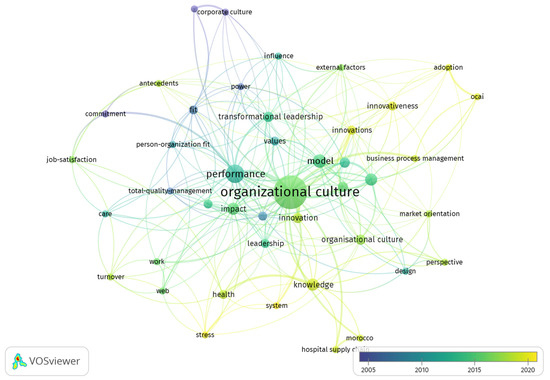
Figure 15.
The map of keywords’ links in time. Source: authors with VOSviewer.
4.3.2. Keywords Analysis for the Documents Referring to OC’s Impact
For the situation of documents referring to OC’s impact, keywords’ analysis begins, as in the previous case (a), with tree charts, both for the keywords provided by the authors (Figure 16) or for keywords PLUS (Figure 17). It can be observed that even in this case, in the scientific literature, prevails the word combination “organizational culture” and only in a certain proportion “organizational culture” appears. The first tree also includes these two keywords as they are also part of the WoS database search. We can see that in the second tree, they no longer appear and that only “corporate culture” is used instead.
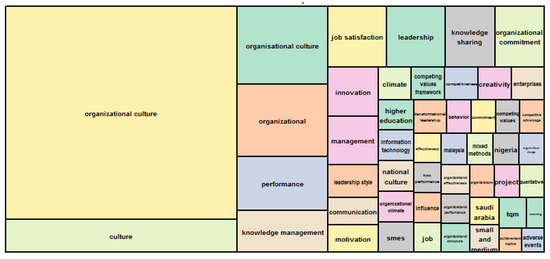
Figure 16.
Authors’ keywords tree. Source: authors with Biblioshiny.
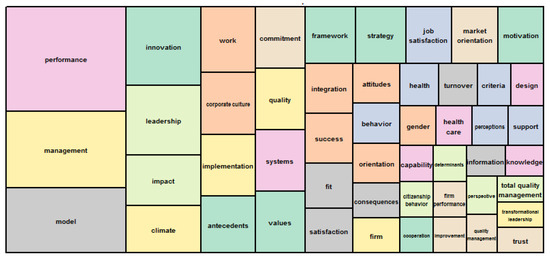
Figure 17.
Keywords PLUS tree. Source: authors with Biblioshiny.
The tree in Figure 16 contains words or phrases related to the impact of CO on the organization, as they were presented in the previous section (the literature review). Thus, the keywords that refer to the impact and influences exerted are: ”performance”, ”innovation”, ”leadership”, ”organizational structure”, ”organizational climate”, ”knowledge sharing”. To these are added those in Figure 17, namely: ”strategy”, ”turnover”, ”competitiveness”.
Going further with the analysis of the graphical elements, Figure 18 shows the map of keywords provided by authors and the links between them. One can see the four shaped colored clusters; the most populated is the one in red, which seems to refer to various elements of management that come to support the organizational culture, keywords such as ”management”, ”knowledge management” ”support”, ”framework”, ”implementation” being located near to ”organisational culture”.
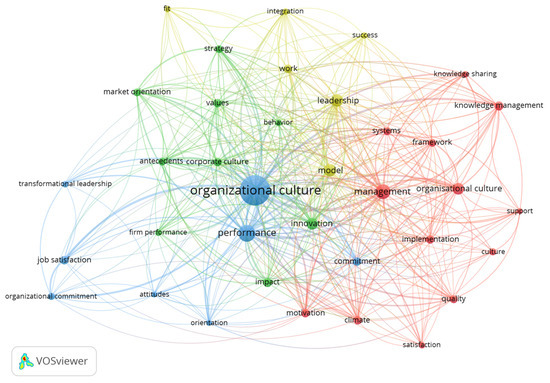
Figure 18.
The map of keywords’ links. Source: authors with VOSviewer.
Thicker branches mean stronger links between keywords, a sign that they have many co-occurrences. In terms of the distribution of themes over time, the map in Figure 19 provides a picture of the period including year 2000, full of keywords connected to the CO (within the yellow cluster).
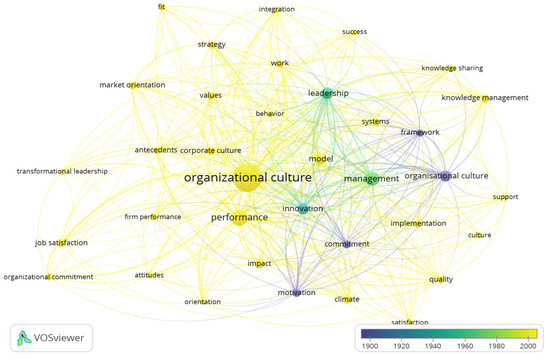
Figure 19.
The map of keywords’ links in time. Source: authors with VOSviewer.
4.4. The Impact of Scientific Documents in the Literature
When referring to the impact of the scientific documents, one can discuss what has happened in the literature since they were published, or how many times they have been cited by other authors who have dealt with similar topics. Having separated the collection into two sets (one related to the determinants of OC and the other concerning the impact of OC) will allow now the results presentation divided into two Figure 20 and Figure 21.
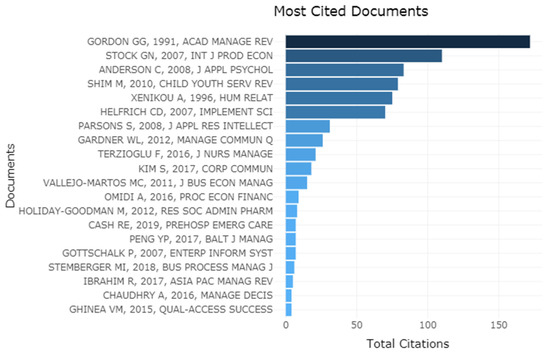
Figure 20.
Documents with the highest number of citations since publication (for set of documents related to the determinants of OC). Source: authors with Biblioshiny.
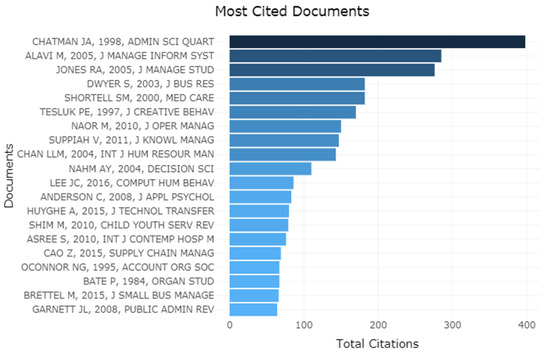
Figure 21.
Documents with the highest number of citations since publication (for set of documents related to the determinants of OC). Source: authors with Biblioshiny.
Gordon’s work [79] managed to collect over 150 citations. It is a work that focuses on the fact that CO is strongly influenced by the characteristics of the industry in which the company operates. In this way, within a certain industry, companies share certain cultural elements that are necessary for survival. In fact, according to the author, there are three classes of industry-related variables that have the potential to create cultural elements: the competitive environment, customer requirements and societal expectations. Ranked second, with over 100 citations are Stock et al. [80]. They focus their study on medical activities and seek to investigate the extent to which organizational culture and specific management techniques can lead to the reduction of medical errors in hospitals in the United States. According to the study, organizational culture has been shown to play an important role in managing errors in hospitals. By developing and maintaining a culture within a hospital that focuses on interpersonal relationships, human resource development, peer training, teamwork and employee training, confidence is built and so is the commitment to work tasks [80]. Moreover, Ruchlin et al. [81] highlighted, in the context of patient safety, two key cultural attributes for improving organizational culture: increased flexibility and learning orientation.
Moving on to the third place of the ranking (less than 100 citations), Anderson et al. [72] treat the degree of employees influence as a factor that contributes to the development of OC. According to the authors, previous research has identified various structural determinants of influence within the organization (formal authority, position in a social network), but indirect evidence suggests that influence may come from individual personal traits. In this regard, the authors tested whether the influence within an entity can come from the match between the person and the organization to which they belong (for instance whether the person identifies with the OC specific to the company). In this regard, unlike Gordon [79] and Stock et al. [80], who talk about the OC as being influenced by the industry, respectively by the management directions, Anderson et al. [72] understand the construction of OC through the individual. Thus, the study showed that extroverts gained more influence in a team-oriented organization, while more conscientious individuals gained more influence in an organization where individuals worked alone on technical tasks.
Moreover, with a similar number of citations as the previous authors, Shim [82] studied in his work the OC and the climate in which employees work, taking into account the emotional involvement given by the child protection service. In the study, OC is classified into achievement/innovation/competence, co-operation/support/receptivity, emphasis on rewards, while organizational climate in clarity of role, personal fulfillment, emotional exhaustion and working tasks. The study showed that OC and climate are significant factors that explain the intention of individuals to leave their jobs. Moreover, improving culture and climate can be achieved by enhancing the reward system and reducing emotional exhaustion.
The work of the authors Chatman et al. [75] with a total of about 400 citations, stands out for the set of documents corresponding to (b) impact of OC, located first place in the ranking in Figure 21.
The next ranked are Alavi et al. [83] (approximately 300 citations), which discuss the concept of knowledge management used to create, store, transfer and apply it in organizations, with OC being considered a significant challenge in knowledge management practices. The paper seeks to explore how OC influences knowledge management practices, with findings showing that OC does influence the use of knowledge management technologies within organizations.
With a similar number of citations, Jones et al. [84] bring to the readers’ attention the phenomenon of preparing for change as a component of OC. Thus, 67 employees working in a government department took part in a study on the implementation of a new computing system. For these employees there was a process of preparing for change, so the analysis showed that a positive effect was reached in terms of employee satisfaction when using the new system because the benefits were stated long before. In practice, the study emphasizes that an OC that encourages change gives rise to positive attitudes among employees and leads to the successful implementation of initiatives because there is no doubt among individuals and expectations are communicated in advance.
With almost 200 citations collected since publication, Shortell et al. [85] try to assess the impact of OC on the degree of care for patients with heart problems. In this sense, the paper evaluates by specific methods the total quality management system (Baldridge criterion), and also the OC (based on 20 previously confirmed observations). Although the paper emphasizes that the effect of OC on the care of patients with heart problems is small, it is necessary to further examine the relationships between individual skills and professional motivations, group-specific processes, special tailored interventions, decision support processes and incentives because all these are treated as components of OC.
5. Conclusions
Developing the bibliometric study included in the present research, allowed the rapid evaluation of the scientific literature regarding the concept of organizational culture, its determining factors, and the influences that OC can further exert. Among findings, the following ones are need further attention: (1) the fact that the topic of the impact of OC has attracted much earlier as a period of time, the attention of researchers (documents on the influences exerted by OC have appeared since 1977, while those related to the determinants of OC in 1990, as identified in WoS database); (2) The United States is by far the largest contributor to the collection of studied documents; (3) graphic representations indicate a low or even very low degree of international collaboration for countries such as Romania, Poland, Iran; (4) the majority of scientific papers are included in the “Business” and “Management” categories of the WoS database, fact expected, if one considers the specifics of the covered topic in this analysis; (5) over 80% of the authors had an unique contribution to the collection of documents, while the percentage of authors who contributed with at least 2 documents is about 5%; (6) Schein, Hofstede and Cameron are the most cited authors in the references of the collection; (7) the main sources that published one third of the documents in the collection are both conference volumes and scientific journals for the set of documents (a), while for the set of documents (b) they are only scientific journals; (8) keyword analysis indicates a higher presence of internal factors that may influence OC, in the collection’s documents (keywords related to factors: Employees, Leadership, Competence and Support) and a lower presence of elements related to external factors influence, such as social, economic and technological; (9) the scientific papers of the collection have a high impact within the literature, obtaining hundreds of citations since publication (the highest number of citations is 400 for Gordon’s research [79]).
As a bibliometric study, this research has its limitations, related to: the database in which the search was conducted (the results could have been different if Scopus would have been used, for example), the words chosen for the WoS search, the fields chosen, and the selected software to process much of the bibliographic information. Another limitation is related to the part of impact analysis. As shown in this paper, for the impact analysis the authors used citation analysis, which in fact can be misleading if one considers some particular reasons for which certain citations are made. Without discussing this now, they deserve to be briefly mentioned: flawed methodology, personal relationship and choosing to cite a particular author or a newer research rather than an older one and so on.
Author Contributions
Conceptualization, all authors; methodology, all authors; validation, C.C. and C.Ț.; formal analysis, all authors; resources, C.M. and N.P.; writing—original draft preparation N.P. and C.M.; writing—review and editing, all authors; supervision, C.C. and C.Ț. All authors have read and agreed to the published version of the manuscript.
Funding
This research received no external funding.
Institutional Review Board Statement
Not applicable.
Informed Consent Statement
Not applicable.
Data Availability Statement
All bibliographic data is available in Web of Science database.
Acknowledgments
This paper is a result of the research developed within the project ”Managementul culturii organizaționale: comparație între sectorul public și cel privat” (Organizational culture management: comparison between public and private sectors) from Bucharest University of Economic Studies.
Conflicts of Interest
The authors declare no conflict of interest.
References
- Hohelska, H.; Sokolova, M. Management approaches for industry 4.0—The organizational culture perspective. Technol. Econ. Dev. Econ. 2018, 24, 2225–2240. [Google Scholar] [CrossRef]
- Streimikiene, D.; Mikalauskiene, A.; Digriene, L.; Kyriakopoulos, G. Assessment of the role of a leader in shaping sustainable organizational culture. Amfiteatru Econ. 2021, 23, 486–503. [Google Scholar]
- Vallejo, M.C. A model to study the organizational culture of the family firm. Small Bus. Econ. 2011, 36, 47–64. [Google Scholar] [CrossRef]
- Stojanovic, E.T.; Vlahovic, M.; Nikolic, M.; Mitic, S.; Jovanovic, Z. The relationship between organizational culture and public relations in business organizations. J. Bus. Econ. Manag. 2020, 21, 1628–1645. [Google Scholar] [CrossRef]
- Zeng, K.S.; Luo, X.H. Impact of ownership type and firm size on organizational culture and on the organizational culture-effectiveness linkage. J. Bus. Econ. Manag. 2013, 14, S96–S111. [Google Scholar] [CrossRef][Green Version]
- Guzal-Dec, D. The role of local government in shaping the eco-friendly organizational culture of offices in communes located in environmentally valuable areas (e.g. The Lublin voivodeship). Ekon. I Srodowisko-Econ. Environ. 2016, 2, 235–248. [Google Scholar]
- Polyanska, A.; Zapukhliak, I.; Oksana, D. Culture of organization in conditions of changes as an ability of efficient transformations: The case of gas transportation companies in Ukraine. Oeconomia Copernic. 2019, 10, 561–580. [Google Scholar] [CrossRef]
- Vatananan-Thesenvitz, R.; Schaller, A.A.; Shannon, R. A bibliometric review of the knowledge base for innovation in sustainable development. Sustainability 2019, 11, 5783. [Google Scholar] [CrossRef]
- Ye, N.; Kueh, T.B.; Hou, L.; Liu, Y.; Yu, H. A bibliometric analysis of corporate social responsibility in sustainable development. J. Clean. Prod. 2020, 272, 122679. [Google Scholar] [CrossRef]
- Nayak, B.; Bhattacharyya, S.S.; Krishnamoorthy, B. Exploring the black box of competitive advantage–An integrated bibliometric and chronological literature review approach. J. Bus. Res. 2022, 139, 964–982. [Google Scholar] [CrossRef]
- Sanguankaew, P.; Vathanophas Ractham, V. Bibliometric review of research on knowledge management and sustainability, 1994–2018. Sustainability 2019, 11, 4388. [Google Scholar] [CrossRef]
- Hallinger, P.; Suriyankietkaew, S. Science mapping of the knowledge base on sustainable leadership, 1990–2018. Sustainability 2018, 10, 4846. [Google Scholar] [CrossRef]
- Cicea, C.; Lefteris, T.; Marinescu, M.; Popa, S.C.; Albu, C.F. Applying text mining technique on innovation-development relationship: A joint research agenda. Econ. Comput. Econ. Cybern. Stud. Res. 2021, 55, 5–21. [Google Scholar]
- Shi, Y.; Tang, Y.R.; Cui, L.X.; Long, W. A text mining based study of investor sentiment and its influence on stock returns. Econ. Comput. Econ. Cybern. Stud. Res. 2018, 52, 183–199. [Google Scholar] [CrossRef]
- Donthu, N.; Kumar, S.; Mukherjee, D.; Pandey, N.; Lim, W.M. How to conduct a bibliometric analysis: An overview and guidelines. J. Bus. Res. 2021, 133, 285–296. [Google Scholar] [CrossRef]
- Kataria, A.; Kumar, S.; Pandey, N. Twenty-Five Years of Gender, Work and Organization: A Bibliometric Analysis; Wiley: Hoboken, NJ, USA, 2020; pp. 1–34. [Google Scholar] [CrossRef]
- Bonilla, D.; Merigo, J.; Torres-Abad, C. Economics in Latin America: A bibliometric analysis. Scientometrics 2015, 105, 1239–1252. [Google Scholar] [CrossRef]
- Zhou, W.; Luo, D.X.; Fang, H.R.; Gou, X.J.; Chen, J. Bibliometric overview and retrospective analysis of fund performance research between 1966 and 2019. Econ. Res.-Ekon. Istraz. 2020, 33, 1510–1537. [Google Scholar] [CrossRef]
- Baker, H.K.; Kumar, S.; Pandey, N. Thirty years of Small Business Economics: A bibliometric overview. Small Bus. Econ. 2020, 56, 487–517. [Google Scholar] [CrossRef]
- Cicea, C.; Marinescu, C.; Pintilie, N. Smart cities using smart choices for energy: Integrating modern bioenergy in consumption. Theor. Empir. Res. Urban Manag. 2019, 14, 22–34. [Google Scholar]
- Gora, A.A. The Link between Decision Making Process and Performance: A Bibliometric Analysis. Manag. Econ. Rev. 2019, 4, 177–191. [Google Scholar] [CrossRef]
- Marinescu, C.; Cicea, C.; Colesca, S.E. Tracking biofuels-innovation relationship through scientific and technological advances. Manag. Res. Pract. 2019, 11, 31–44. [Google Scholar]
- Pintilie, N.; Cicea, C.; Marinescu, C. A bibliometric study of environmental protection and economic development: Revealing links and dynamics. In Proceedings of the 14th International Management Conference: Managing Sustainable Organizations, Bucharest, Romania, 5–6 November 2020; pp. 335–345. [Google Scholar]
- Popa, I.; Gora, A.A. Bibliometric Analysis of the Links between Knowledge Management and Competitive Advantage. In The Best Romanian Management Studies 2017–2018; Trivent Publishing: Budapest, Hungary, 2020; p. 66. [Google Scholar]
- Cicea, C.; Marinescu, C. Bibliometric analysis of foreign direct investment and economic growth relationship. A research agenda. J. Bus. Econ. Manag. 2021, 22, 445–466. [Google Scholar] [CrossRef]
- Donthu, N.; Kumar, S.; Pattnaik, D. Forty-five years of Journal of Business Research: A bibliometric analysis. J. Bus. Res. 2020, 109, 1–14. [Google Scholar] [CrossRef]
- Khan, M.; Pattnaik, D.; Ashraf, R.; Ali, I.; Kumar, S.; Donthu, N. Value of special issues in the Journal of Business Research: A bibliometric analysis. J. Bus. Res. 2021, 125, 295–313. [Google Scholar] [CrossRef]
- Reis, N.; Ferreira, M.P.; Santos, J.C.; Serra, F.R. A bibliometric study of the cultural models in international business research. BASE-Rev. Adm. Contab. Unisinos 2013, 10, 340–354. [Google Scholar]
- Teravainen, V.; Suominen, A.; Kahkonen, K. Positioning Organizational Culture Studies between the Construction Industry and Other Industries. In Proceedings of 9th Nordic Conference on Construction Economics and Organization, Göteborg, Sweden, 12–14 June 2017. [Google Scholar]
- Cui, Y.; Liu, Y.; Mou, J. Bibliometric analysis of organisational culture using CiteSpace. S. Afr. J. Econ. Manag. Sci. 2018, 21, 1–12. [Google Scholar] [CrossRef]
- Van Nunen, K.; Li, J.; Reniers, G.; Ponnet, K. Bibliometric analysis of safety culture research. Saf. Sci. 2018, 108, 248–258. [Google Scholar] [CrossRef]
- Leyva Duarte, J.E.; Chávez Martínez, J.D.J.; Pinedo de Anda, F.J.; Niebla Zatarain, J.C. Bibliometric analysis of Organizational culture in Business economics of Web of Science, 1980-2018. Nova Scientia 2019, 11, 478–500. [Google Scholar] [CrossRef]
- Duarte, J.E.L.; de la Garza Carranza, M.T.; Martínez, J.D.J.C.; de Anda, F.J.P.; Zatarain, J.C.N.; Farías, J.P.G. Organizational culture in the hospitality industry a bibliometric analysis and systematic literature review. Indep. J. Manag. Prod. 2020, 11, 1140–1162. [Google Scholar] [CrossRef]
- Kitsios, F.; Kamariotou, M.; Talias, M.A. Corporate sustainability strategies and decision support methods: A bibliometric analysis. Sustainability 2020, 12, 521. [Google Scholar] [CrossRef]
- Montini, P.; Araújo Pinho, C.M.; Nogueira de Oliveira, R.M.; Costa, I.; Rodrigues Napolitano, D.M. Evaluation of the relationship between Lean Philosophy and Organizational Culture: A bibliometric review. Res. Soc. Dev. 2020, 9. [Google Scholar] [CrossRef]
- El Baz, J.; Iddik, S. Green supply chain management and organizational culture: A bibliometric analysis based on Scopus data (2001–2020). Int. J. Organ. Anal. 2021, 30, 156–179. [Google Scholar] [CrossRef]
- Arti, M. Impact of Organisational Culture on Work-Life Balance a Bibliometric Analysis and Growth in Research. Eur. J. Mol. Clin. Med. 2021, 7, 5308–5319. [Google Scholar]
- Oriade, A.; Osinaike, A.; Aduhene, K.; Wang, Y. Sustainability awareness, management practices and organizational culture in hotels: Evidence from developing countries. Int. J. Hosp. Manag. 2021, 92, 1–12. [Google Scholar] [CrossRef]
- Freedom Learning Group. Internal Factors of Organizational Culture. Available online: https://courses.lumenlearning.com/wmopen-organizationalbehavior/chapter/internal-factors-of-organizational-culture/#return-footnote-812-2 (accessed on 9 July 2021).
- Szczepańska, K.; Kosiorek, D. Factors influencing organizational culture. Zesz. Naukowe. Organ. I Zarządzanie/Politech. Śląska 2017, 100, 457–468. [Google Scholar] [CrossRef]
- Freedom Learning Group. External Factors of Organizational Culture. Available online: https://courses.lumenlearning.com/wmopen-organizationalbehavior/chapter/external-factors-of-organizational-culture/ (accessed on 9 July 2021).
- Kapur, R. Determinants of Organizational Culture. 2020. Available online: https://www.researchgate.net/publication/347411176_Determinants_of_Organizational_Culture (accessed on 9 July 2021).
- Shao, Z.; Feng, Y.; Liu, L. The Mediating Effect of Organizational Culture and Knowledge Sharing on Transformational Leadership and Enterprise Resource Planning Systems Success: An Empirical Study in China. Comput. Hum. Behav. 2012, 28, 2400–2413. [Google Scholar] [CrossRef]
- Vaiseh, S.; Mohammadi, E.; Pirzadian, M.; Sharafi, V. The Relation between Transformational Leadership and Organizational Culture (Case study: Medical School of Ilam). J. Bus. Stud. Q. 2014, 5, 113–124. [Google Scholar]
- Bateman, T.S.; Snell, S.A. Management, 11th ed.; McGraw-Hill: New York, NY, USA, 2015. [Google Scholar]
- Aryani, R.; Widodo, W. The Determinant of Organizational Culture and Its Impact on Organization: A Conceptual Framework. Int. J. High. Educ. 2020, 9, 64–70. [Google Scholar] [CrossRef]
- Bass, B.M.; Avolio, B.J. Improving Organizational Effectiveness through Transformational Leadership; Sage Publications: Thousand Oaks, CA, USA, 1994. [Google Scholar]
- DeVito, J.A. Komunikasi Antarmanusia; Professional Books: Jakarta, Indonesia, 1997. [Google Scholar]
- Lim, B. Examining the Organizational Culture and Organizational Performance Link. Leadersh. Organ. Dev. J. 1995, 16, 16–21. [Google Scholar] [CrossRef]
- Shahzad, F.; Luqman, R.A.; Khan, A.R.; Shabbir, L. Impact of Organizational Culture on Organizational Performance: An Overview. Interdiscip. J. Contemp. Res. Bus. 2012, 3, 975–985. [Google Scholar]
- Saffold, G.S. Culture Traits, Strength, and Organizational Performance: Moving beyond Strong Culture. Acad. Manag. Rev. 1998, 13, 546–558. [Google Scholar]
- Szczepańska-Woszczyna, K. The Importance of Organizational Culture for Innovation in the Company. Forum Sci. Oeconomia Vol. 2014, 2, 27–39. [Google Scholar]
- Matinaro, V.; Liu, Y. Towards increased innovativeness and sustainability through organizational culture: A case study of a Finnish construction business. J. Clean. Prod. 2017, 142, 3184–3193. [Google Scholar] [CrossRef]
- WCED. Our Common Future; Oxford University Press: Oxford, UK, 1987. [Google Scholar]
- Isensee, C.; Teuteberg, F.; Griese, K.M.; Topi, C. The relationship between organizational culture, sustainability, and digitalization in SMEs: A systematic review. J. Clean. Prod. 2020, 275, 1–19. [Google Scholar] [CrossRef]
- Grayson, D.; Coulter, C.; Lee, M. All in: The future of Business Leadership; Routledge: London, UK, 2018. [Google Scholar]
- Johnson, M.P. Sustainability Management and Small and Medium-Sized Enterprises: Managers’ Awareness and Implementation of Innovative Tools. Corp. Soc. Responsib. Environ. Manag. 2013, 22, 271–285. [Google Scholar] [CrossRef]
- Singh, M.P.; Chakraborty, A.; Roy, M. Entrepreneurial commitment, organizational sustainability and business performance of manufacturing msmes: Evidence from India. Int. J. Appl. Bus. Econ. Res. 2016, 14, 4615–4631. [Google Scholar]
- Nunes, J.R.R.; da Silva, J.E.A.R.; Moris, V.A.d.S.; Giannetti, B.F. Cleaner Production in small companies: Proposal of a management methodology. J. Clean. Prod. 2019, 218, 357–366. [Google Scholar] [CrossRef]
- Roxas, B.; Coetzer, A. Institutional Environment, Managerial Attitudes and Environmental Sustainability Orientation of Small Firms. J. Bus. Ethics 2012, 111, 461–476. [Google Scholar] [CrossRef]
- Chen, Y.S. Green organizational identity: Sources and consequence. Manag. Decis. 2011, 49, 384–404. [Google Scholar] [CrossRef]
- Widya-Hasuti, A.; Mardani, A.; Streimikiene, D.; Sharifara, A.; Cavallaro, F. The Role of Process Innovation between Firm-Specific Capabilities and Sustainable Innovation in SMEs: Empirical Evidence from Indonesia. Sustainability 2018, 10, 2244. [Google Scholar] [CrossRef]
- Kiefer, C.P.; Del Rio Gonzalez, P.; Carrillo-Hermosilla, J. Drivers and barriers of eco-innovation types for sustainable transitions: A quatitative perspective. Bus. Strategy Environ. 2018, 28, 155–172. [Google Scholar] [CrossRef]
- Munoz-Pascual, L.; Curado, C.; Galende, J. The Triple Bottom Line on Sustainable Product Innovation Performance in SMEs: A Mixed Methods Approach. Sustainability 2019, 11, 1689. [Google Scholar] [CrossRef]
- Linnenluecke, M.K.; Griffiths, A. Corporate sustainability and organizational culture. J. World Bus. 2010, 45, 357–366. [Google Scholar] [CrossRef]
- Loewe, P.; Dominiquini, J. Overcoming the barriers to effective innovation. Strategy Leadersh. 2006, 34, 24–31. [Google Scholar] [CrossRef]
- Salehi, M.; Fahimi, M.A.; Zimon, G.; Homayoun, S. The effect of knowledge management on intellectual capital, social capital, and firm innovation. J. Facil. Manag. 2021. [Google Scholar] [CrossRef]
- Janik, A.; Ryszko, A.; Szafraniec, M. Mapping the Field of Smart Specialisation and Regional Innovation Strategy Literature—A Bibliometric Analysis. Eur. Res. Stud. J. 2020, 23, 655–673. [Google Scholar] [CrossRef]
- Aria, M.; Cuccurullo, C. bibliometrix: An R-tool for comprehensive science mapping analysis. J. Informetr. 2017, 11, 959–975. [Google Scholar] [CrossRef]
- Conțiu, L.C. A study concerning organizational culture and its influence on knowledge management. In Proceedings of the 4th International Conference on Management of Technological Changes, Chania, Greece, 19–20 August 2005. [Google Scholar]
- Conțiu, L.C. Organizational culture factors that-may influence the competitiveness of higher education institutions. In Proceedings of the 4th International Seminar on Quality Management in Higher Education, Sinaia, Romania, 9–10 June 2006. [Google Scholar]
- Anderson, C.; Spataro, S.E.; Flynn, F.J. Personality and organizational culture as determinants of influence. J. Appl. Psychol. 2008, 93, 702. [Google Scholar] [CrossRef]
- Amer, T.S. A Framework Analysis of the Relation between Information Technology and Performance: The Influence of Operational Change Factors and Organizational Culture—Discussion. In Proceedings of the Annual Accounting Information Systems Research Symposium, Phoenix, AZ, USA, 20–22 February 1997. [Google Scholar]
- Dunk, A.S.; Roohani, S.J. Technology Policy, Task Uncertainty and Organisational Performance. J. Manag. Organ. 1998, 4, 1–13. [Google Scholar] [CrossRef]
- Chatman, J.A.; Polzer, J.T.; Barsade, S.G.; Neale, M.A. Being different yet feeling similar: The influence of demographic composition and organizational culture on work processes and outcomes. Adm. Sci. Q. 1998, 43, 749–780. [Google Scholar] [CrossRef]
- Singh, P.; Mathew, T.; Das, G.S. Organizational Culture and Its Impact on Managerial Remuneration. Indian Inst. Manag. Calcutta 1977, 13, 1–14. [Google Scholar]
- Singh, P.; Das, G.S. Organizational culture and its impact on commitment to work. Indian J. Ind. Relat. 1978, 13, 511–524. [Google Scholar]
- Kalra, G.; Kaur, R.; Ichhpujani, P.; Chahal, R.; Kumar, S. COVID-19 and ophthalmology: A scientometric analysis. Indian J. Ophthalmol. 2021, 69, 1234. [Google Scholar] [PubMed]
- Gordon, G.G. Industry Determinants of Organizational Culture. Acad. Manag. Rev. 1991, 16, 396–415. [Google Scholar] [CrossRef]
- Stock, G.N.; McFadden, K.L.; Gowen, C.R. Organizational culture, critical success factors, and the reduction of hospital errors. Int. J. Prod. Econ. 2006, 106, 368–392. [Google Scholar] [CrossRef]
- Rutchlin, H.S.; Dubbs, N.L.; Callahan, M.A. The role of leadership in instilling a culture of safety: Lessons from the literature. J. Healthc. Manag. 2004, 49, 47–59. [Google Scholar]
- Shim, M. Factors influencing child welfare employee’s turnover. Focusing on organizational culture and climate. Child. Youth Serv. Rev. 2010, 32, 847–856. [Google Scholar] [CrossRef]
- Alavi, M.; Kayworth, T.R.; Leidner, D.E. An Empirical Examination of the Influence of Organizational Culture on Knowledge Management Practices. J. Manag. Inf. Syst. 2006, 22, 191–224. [Google Scholar] [CrossRef]
- Jones, R.A.; Jimmieson, N.L.; Griffiths, A. The Impact of Organizational Culture and Reshaping Capabilities on Change Implementation Success: The Mediating Role of Readiness for Change. J. Manag. Stud. 2005, 42, 361–386. [Google Scholar] [CrossRef]
- Shortell, S.M.; Jones, R.H.; Rademaker, A.W.; Gillies, D.S.; Dranove, E.F.; Hughes, E.F.; Budetti, P.P.; Reynolds, K.S.E.; Huang, C.-F. Assessing the impact of total quality management and organizational culture on multiple outcomes of care for coronary artery bypass graft surgery patients. Med. Care 2000, 38, 207–217. [Google Scholar] [CrossRef]
Publisher’s Note: MDPI stays neutral with regard to jurisdictional claims in published maps and institutional affiliations. |
© 2022 by the authors. Licensee MDPI, Basel, Switzerland. This article is an open access article distributed under the terms and conditions of the Creative Commons Attribution (CC BY) license (https://creativecommons.org/licenses/by/4.0/).